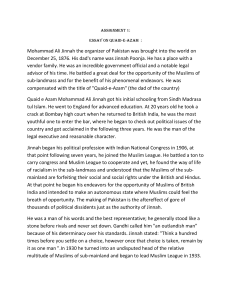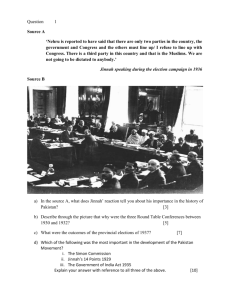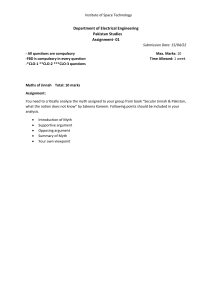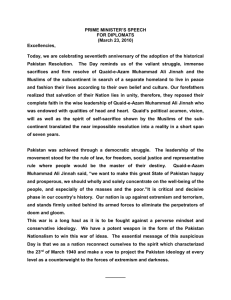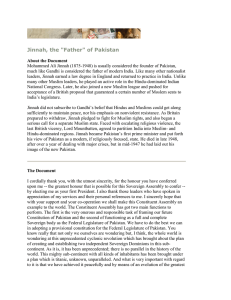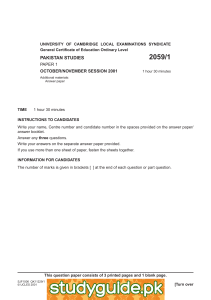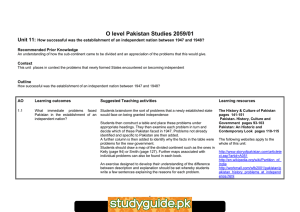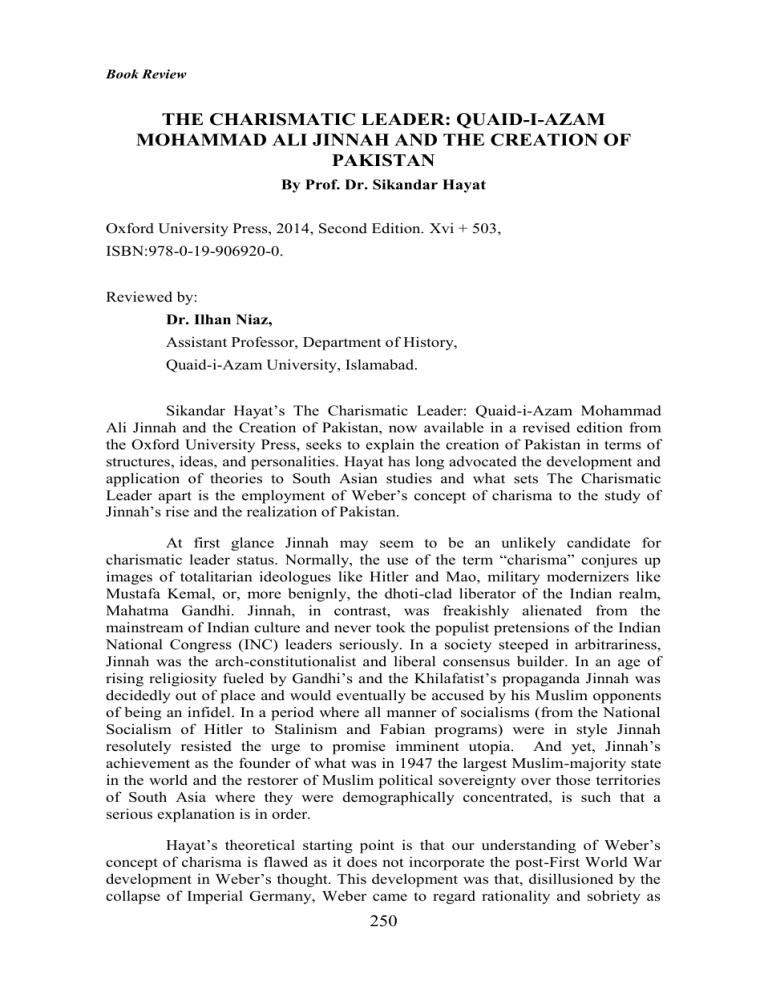
Book Review THE CHARISMATIC LEADER: QUAID-I-AZAM MOHAMMAD ALI JINNAH AND THE CREATION OF PAKISTAN By Prof. Dr. Sikandar Hayat Oxford University Press, 2014, Second Edition. Xvi + 503, ISBN:978-0-19-906920-0. Reviewed by: Dr. Ilhan Niaz, Assistant Professor, Department of History, Quaid-i-Azam University, Islamabad. Sikandar Hayat’s The Charismatic Leader: Quaid-i-Azam Mohammad Ali Jinnah and the Creation of Pakistan, now available in a revised edition from the Oxford University Press, seeks to explain the creation of Pakistan in terms of structures, ideas, and personalities. Hayat has long advocated the development and application of theories to South Asian studies and what sets The Charismatic Leader apart is the employment of Weber’s concept of charisma to the study of Jinnah’s rise and the realization of Pakistan. At first glance Jinnah may seem to be an unlikely candidate for charismatic leader status. Normally, the use of the term “charisma” conjures up images of totalitarian ideologues like Hitler and Mao, military modernizers like Mustafa Kemal, or, more benignly, the dhoti-clad liberator of the Indian realm, Mahatma Gandhi. Jinnah, in contrast, was freakishly alienated from the mainstream of Indian culture and never took the populist pretensions of the Indian National Congress (INC) leaders seriously. In a society steeped in arbitrariness, Jinnah was the arch-constitutionalist and liberal consensus builder. In an age of rising religiosity fueled by Gandhi’s and the Khilafatist’s propaganda Jinnah was decidedly out of place and would eventually be accused by his Muslim opponents of being an infidel. In a period where all manner of socialisms (from the National Socialism of Hitler to Stalinism and Fabian programs) were in style Jinnah resolutely resisted the urge to promise imminent utopia. And yet, Jinnah’s achievement as the founder of what was in 1947 the largest Muslim-majority state in the world and the restorer of Muslim political sovereignty over those territories of South Asia where they were demographically concentrated, is such that a serious explanation is in order. Hayat’s theoretical starting point is that our understanding of Weber’s concept of charisma is flawed as it does not incorporate the post-First World War development in Weber’s thought. This development was that, disillusioned by the collapse of Imperial Germany, Weber came to regard rationality and sobriety as 250 Book Review by Dr. Ilhan Niaz core qualities of authentic charismatic leadership. The importance of personal charisma being institutionalized in the state or political party was equally important for otherwise charismatic leaders would be little more than demagogues with a death wish. Having clarified this important point, Hayat proceeds to provide the historical and socio-political context in which Jinnah operated and eventually emerged as the leader of the Muslims. In this Hayat identifies certain conditions that needed to be met for a charismatic leader to emerge. The first condition is that of a crisis that has the potential to imperil the core interests of a group or a community. In the context of Muslim India this crisis had several dimensions. First, the Muslims were demographically in a minority and as India headed towards greater representation in local, provincial, and, eventually, central, governments, inferior numbers translated into reduction of the Muslims to the status of a permanent minority in most of the provinces and local government, as well as in the central government. Second, numbers aside, colonial representation was determined by educational, property, and income qualifications, and here, even in those territories where the Muslims were in a majority, they were underrepresented due to their backwardness. Third, as demands for self-government escalated during and after the First World War the question of British imperial succession became the central long-term issue of Indian politics. The Congress was quite clear on what it wanted – a British exit accompanied by handing over power to a strong central government that would operate on the basis of universal suffrage and pretend minorities were diabolical contrivances of the Raj. The local and provincial Muslim leaders had little to say about what kind of India would emerge if the British left and many hitched their wagons to the Congress hoping for some magnanimous concessions that might materialize after a centralized, majoritarian, democracy, under the Congress had come into existence. Hayat makes the case that among the Muslim leaders Jinnah alone had a long-term perspective on the evolving situation. He understood that the real question was the distribution of sovereign power and that the Muslims needed to get organized so that they too could have a say in what an independent South Asia might look like. In terms of vision, Jinnah advocated a formula in the form of the Lahore Resolution of March 23, 1940 (dubbed the “Pakistan” Resolution by its critics). The formula was vague and deliberately so, but it held out the promise that sovereignty would be restored to the Muslims wherever they were in a majority. For Hayat, the ambiguity of the formula led people to read into their own preferences or fears, and it focused the attention of the Muslims, and the Muslim League, on a grand objective. Opposition to the “Pakistan” scheme served to lend it substance and turned it into a key component of Indian political discourse. Actually organizing the Muslims to achieve this objective was a very difficult task and one in which Jinnah did not succeed as much he would have liked to. Still, the growth of the Muslim League between 1940 and 1945 was considerable, while the Second World War made it evident that the actual succession to British rule was at hand. Hayat explains in detail the mobilization strategy of the Muslim League, its activation of students, women, traditional elites, businessmen, and at least some ulema and the creation of a national coalition. The 251 Journal of Research Society of Pakistan – Vol. 54, No. 1, January-June, 2017 growth of the League was such that by 1946 it claimed all the Muslim seats at the center and nearly all at the provincial level. With such a resounding victory, the time for finally working out what Pakistan meant had arrived and here Jinnah was prepared to accept a sovereign Muslim India within an Indian confederation, or, failing that, an independent Pakistan with no constitutional connection to India. Once the Congress reneged on the Cabinet Mission Plan, which promised the former, Jinnah had no compunctions about doing what was necessary to carve an independent Muslim-majority state out of the British Empire in India and moving towards the latter option. For Hayat, the creation of Pakistan and its consolidation meant that Jinnah’s mission had been accomplished and his charisma was routinized in the new state. So, at a structural level, the demand for Pakistan was the outcome of internal asymmetries of demography, economy, and socio-political consciousness, which had emerged during the British Raj. These asymmetries, barely managed by concessions, reforms, and repression, threatened to permanently erase the Muslims as a political community and became unmanageable as the British Empire went into decline after the First World War. The central question was of succession, and here Jinnah picked his idea and timing perfectly, which was to advocate the restoration of sovereignty to the Muslim-majority areas of South Asia. The idea resonated and connected with the anxiety and distress of the Muslim triggering the Pakistan Movement. Jinnah’s leadership in terms of organization of the League, deal-making, and negotiating with the British, the Congress, and other groups, led to extraordinary electoral success in 1946. This success meant that Pakistan would either come into existence as a vast Muslim-majority sovereign region that comprised the whole of present-day Pakistan and Bangladesh plus the Hindumajority areas of Bengal and Punjab, or as a smaller but completely independent state. Acceding to either of these options was galling to the Congress, but Jinnah’s success was that they now had to choose between a notionally sovereign united India or an actually sovereign divided India. The Congress’s pain and confusion were evident in its dithering as it went from preferring a loose confederation and then changed its mind and went for the two-state solution. Hayat’s The Charismatic Leader is a fine study of political leadership in South Asia. Historically grounded, theoretically sound, and argumentatively plausible, it provides a rich starting point for further debate and scholarship. What sets Hayat apart from other writers is that he seeks to explain Jinnah’s leadership in terms of phenomena, leadership and in doing so breaks new ground. Scholars, students, and the general readership can all benefit from the book under review. 252
